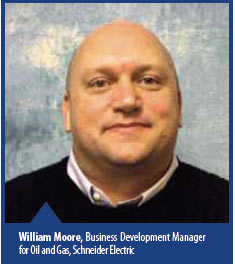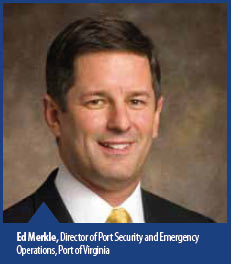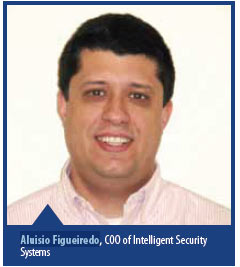Thanks to continued R&D efforts, the integration of old and new systems, as well as people and machines, is a much smoother experience than before.
The need to integrate various security systems for a seaport transcends from safety reasons to operational efficiency concerns. Installation and integration works can be challenging for solution providers as seaports operate almost 24/7, said William Moore, Business Development Manager for Oil and Gas, Schneider Electric.
“Solution providers need to be able to work around the port schedule, and the best practice is to keep an open line of communication with the security committee and all parties at the port. For example, down time needs to be addressed when security measures are implemented.”
Thanks to continued R&D efforts, the integration of old and new systems, as well as people and
machines, is a much smoother experience than before.
The need to integrate various security systems for a seaport transcends from safety reasons to operational efficiency concerns. Installation and integration works can be challenging for solution providers as seaports operate almost 24/7, said William Moore, Business Development Manager for Oil and Gas, Schneider Electric.
“Solution providers need to be able to work around the port schedule, and the best practice is to keep an open line of communication with the security committee and all parties at the port. For example, down time needs to be addressed when security measures are implemented.” 
Smooth and quick installations and integrations can be done when the operations team at the seaport is involved. “Once the needs of the security team, the operations team and other stakeholders are understood, it is much easier to select a security solution that meets most objectives,” said Larry Bowe, President of PureTech Systems.
 Among diverse choices, seaports particularly look for smooth, total site management. “There actually are best practices for continuous system integration that maintains backward compatibility while making new system capabilities available,” Bowe said. “With the increased popularity of XML, interfaces between products and subsystems can be extended without breaking previous integrations. This method is sometimes referred to as loosely coupled integration. When engineered properly, systems can process the information they understand and simply ignore the information they don't understand. Existing functionality continues to work, and new functionality is available if the receiving system knows what to do with the new information.”
Among diverse choices, seaports particularly look for smooth, total site management. “There actually are best practices for continuous system integration that maintains backward compatibility while making new system capabilities available,” Bowe said. “With the increased popularity of XML, interfaces between products and subsystems can be extended without breaking previous integrations. This method is sometimes referred to as loosely coupled integration. When engineered properly, systems can process the information they understand and simply ignore the information they don't understand. Existing functionality continues to work, and new functionality is available if the receiving system knows what to do with the new information.”
 Central management software, such as physical security information management (PSIM), takes full advantage of this open system practice in order to make sense and use of the mass amount of data at hand. “The PSIM should not only integrate all systems on site for real-time data streaming, it should also connect to agencies outside the seaport, such as the National Oceanic and Atmospheric Administration (NOAA) for the U.S., for crucial and relevant information that affects seaport operations,” said Ed Merkle, Director of Port Security and Emergency Operations, Port of Virginia. When a situation occurs, a PSIM solution should present SOPs based on the organization's policies and processes, said James Chong, CTO of VidSys.
Central management software, such as physical security information management (PSIM), takes full advantage of this open system practice in order to make sense and use of the mass amount of data at hand. “The PSIM should not only integrate all systems on site for real-time data streaming, it should also connect to agencies outside the seaport, such as the National Oceanic and Atmospheric Administration (NOAA) for the U.S., for crucial and relevant information that affects seaport operations,” said Ed Merkle, Director of Port Security and Emergency Operations, Port of Virginia. When a situation occurs, a PSIM solution should present SOPs based on the organization's policies and processes, said James Chong, CTO of VidSys.
“One weekend, the live feed from NOAA to our PSIM reported a thunderstorm warning 27 minutes before it was reported on the local news outlets, and the PSIM was able to guide the operator what should be done as preparatory procedures,” Merkle recounted.
BOY WHO CRIED WOLF
 Without exceptions, many perimeter and VCA setups at seaports produce false alarms. “The combination of basic perimeter fences with simple or smart cameras does not yield an adequate level of security in many cases,” said Hagai Katz, Senior VP of Marketing and Business Development, Magal Security Systems. “Ineffective perimeter protection can create many false alarms, which, in addition to being both time-consuming and costly to verify, can cause security personnel to lose vigilance.”
Without exceptions, many perimeter and VCA setups at seaports produce false alarms. “The combination of basic perimeter fences with simple or smart cameras does not yield an adequate level of security in many cases,” said Hagai Katz, Senior VP of Marketing and Business Development, Magal Security Systems. “Ineffective perimeter protection can create many false alarms, which, in addition to being both time-consuming and costly to verify, can cause security personnel to lose vigilance.”
Fine-tuning the entire system should be carried out during initial installation, and should be performed by a trained integrator, recommended Aluisio Figueiredo, COO of Intelligent Security Systems.
BRIDGING THE PAST AND PRESENT
One way to facilitate the process of phasing out the old and bringing in the new is to use encoders and digital virtual matrix switches, Chong said. This kind of hybrid infrastructure is common for today's seaports before becoming fully IP-based.
When migrating, vendors of older technologies/equipment may no longer be around, rendering APIs/ SDKs impossible to get. The standard work-around is through dry contacts, but then the network and some functions might be lost, Katz said.
“Usually, we try to find out what the protocol is via analyzers and network sniffers,” Figueiredo said. “If this proves to be unseccessful, we then use dry contacts and relays to integrate such systems.”
In the U.S., if solution providers go out of business, the support organization that received the rights and ownership of the software for interface support would be reached, said Pat Kiernan, Marketing Director for the Americas, Nice Systems.
“Almost all software providers have their code stored with a law office or similar entity as a protection for the customer in case of bankruptcy. It is usually a requirement in requests for proposal.”
“At the onset of a project, the seaport can request manufacturers to place designs in escrow that can be released to the port should they cease to offer a viable replacement or cease to exist,” Bowe added. “That way, the port can hire an integrator directly to maintain the applicable system component.”
Wouldn't ripping out the old system and switching to a completely new system be better? This comes down to a cost/benefit analysis of the end user. “Of course, if there is no one available to support the system, then little choice is left but to replace the old system when it begins to fail,” Bowe said. Also, once the seaport security personnel notices video loss or distrust in the existing system, it would be better to make way for a completely new system, Moore added.
For old equipment that is still up and running, Moore suggested moving it to a low-traffic, less critical area for a small cost without sacrificing security coverage. “The use of new technology in critical and high-traffic areas is highly recommended. With the advances made in HD, wide dynamic, megapixel and low-light cameras, seaports would be better off converting to better, newer technology.”